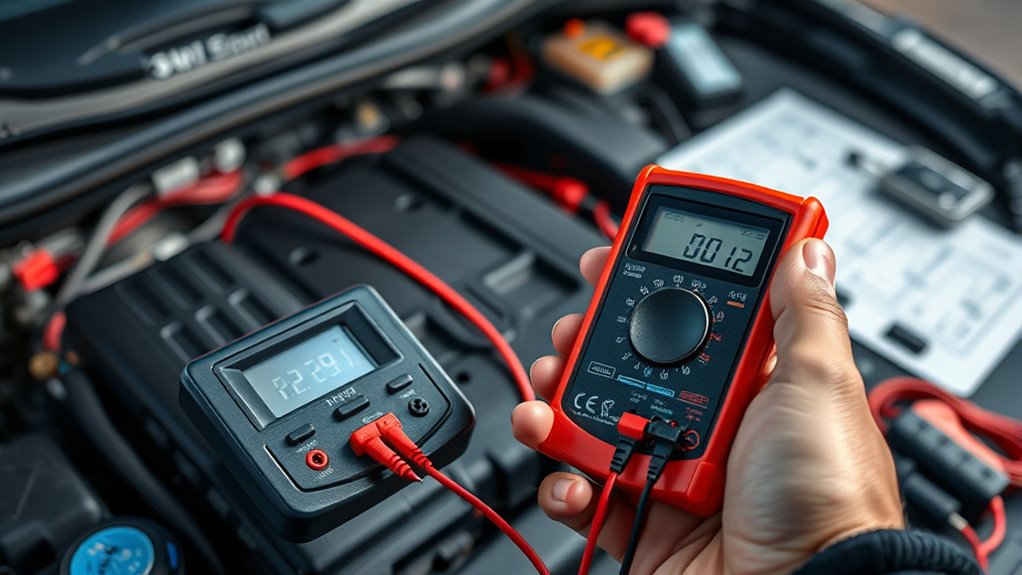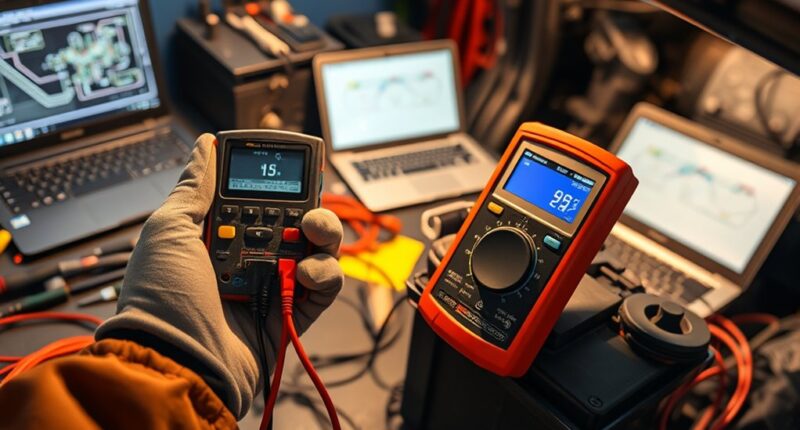To solve a battery drain mystery, start by turning off your vehicle and disconnecting the negative battery terminal. Use a multimeter set to measure current and connect it in series between the battery and cable. Remove fuses one at a time, watching for a drop in current that indicates the faulty circuit. Check the alternator’s voltage output and inspect fuses for damage. Following these steps will help you identify the culprit—continue exploring to learn more about fixing the issue effectively.
Key Takeaways
- Turn off all accessories and disconnect the negative battery terminal before testing.
- Use a multimeter set to measure current and connect it in series to identify parasitic draw.
- Remove fuses one at a time to pinpoint the circuit causing excessive drain.
- During engine operation, verify alternator voltage is between 13.8 and 14.4 volts for proper function.
- Systematically diagnose fuse integrity, alternator health, and parasitic draw to resolve the battery drain issue.

If you’ve ever experienced your device’s battery draining unexpectedly fast, you’re not alone. Many vehicle owners face this frustrating problem, often wondering what’s causing the unexpected power loss. One common culprit is parasitic draw, which happens when electrical components continue to draw power even after you turn off your vehicle. To pinpoint the issue, performing a parasitic draw test is essential, but before diving into that, it’s helpful to understand some typical causes, like alternator failure and fuse issues. Alternator failure can sometimes be overlooked, but it’s a key factor because a failing alternator might not properly regulate voltage, causing your battery to drain faster than it should. When an alternator doesn’t charge the battery properly, the vehicle’s electrical system pulls power directly from the battery, leading to quicker depletion. Additionally, fuse issues can also cause parasitic drain. A blown fuse or a faulty fuse connection may lead to electrical components malfunctioning or remaining energized, which inadvertently drains the battery even when the vehicle is off.
Before testing, verify your vehicle is turned off and all accessories are disconnected. Your goal is to measure the current flowing from the battery, which should be minimal when everything is shut down. To do this accurately, you’ll need a multimeter set to measure current (amperes). Open the hood and locate the battery terminal. Disconnect the negative terminal and connect the multimeter’s leads in series—one to the battery post and the other to the cable. This setup allows you to read the current draw directly. A normal parasitic draw typically ranges from 20 to 50 milliamps, but anything considerably higher indicates a problem. If you see a high reading, start by removing fuses one at a time and watching the meter. When the current drops considerably, you’ve identified the circuit responsible for the drain. This process helps you narrow down whether the issue stems from a fuse issue, an accessory, or a component linked to the alternator.
If fuses are intact and the current draw persists, consider the alternator’s health. You might need to test the alternator’s voltage output with the engine running—ideally, it should be between 13.8 and 14.4 volts. A lower or erratic voltage indicates alternator failure, which can cause battery drain. Sometimes, a failing alternator may also cause fuse issues if internal components short or malfunction. By systematically checking the fuse box, alternator output, and conducting a parasitic draw test, you’ll be better equipped to diagnose and fix the root cause of your battery drain mystery.
Frequently Asked Questions
How Can I Prevent Parasitic Drain in My Vehicle?
To prevent parasitic drain in your vehicle, focus on good battery maintenance and ensuring your vehicle security systems are properly configured. Regularly check for faulty or outdated electronics that could cause battery drain. Turn off all accessories when parking and disconnect the battery if you won’t drive for a long time. Additionally, keep security systems updated and properly installed to avoid unnecessary power draw, helping your battery stay healthy longer.
What Tools Are Essential for a Parasitic Draw Test?
To perform a parasitic draw test, you’ll need a reliable multimeter with a suitable current range to detect small draws, so carefully select one that can measure at least 10 amps. You should also use a fuse puller to safely remove fuses without damaging them. These tools help you accurately identify any abnormal current flow, making it easier to pinpoint the source of the drain and prevent battery issues.
How Long Should a Parasitic Draw Test Take?
You should plan for a parasitic draw test to take about 15 to 30 minutes. This duration allows you to accurately monitor the electrical system and identify any abnormal drain without rushing. During the test, you’ll check for consistent power draw, which is essential for proper battery maintenance. Rushing can lead to missed issues, so make certain you have enough time to observe the system’s behavior and pinpoint the source of the drain.
Can a Faulty Alternator Cause Parasitic Drain?
A faulty alternator can definitely cause parasitic drain if it malfunctions, leading to issues in your electrical system. When the alternator has an malfunction, it may continue drawing power even when the vehicle is off, draining your battery over time. This ongoing electrical system problem can mimic other parasitic draws, making it important to have your alternator checked if you notice unexplained battery drain, especially after the vehicle has been off for a while.
Is It Safe to Perform a Parasitic Draw Test at Home?
Performing a parasitic draw test at home can be safe if you follow proper procedures and prioritize battery safety. You’ll need to disconnect the battery and use a multimeter to check for excess current draw, but make sure your hands stay dry and you handle the equipment carefully. While it’s doable for DIY enthusiasts, always consult your vehicle’s manual and consider professional help if you’re unsure to avoid damaging your battery or vehicle.
Conclusion
Now that you know how to perform a parasitic draw test, you can confidently identify hidden battery drains. For example, imagine discovering a faulty aftermarket alarm causing your car’s battery to drain overnight. By following the steps, you save time and avoid costly repairs. With this guide, you’re equipped to solve battery drain mysteries efficiently, ensuring your vehicle stays powered and ready to go whenever you need it.










